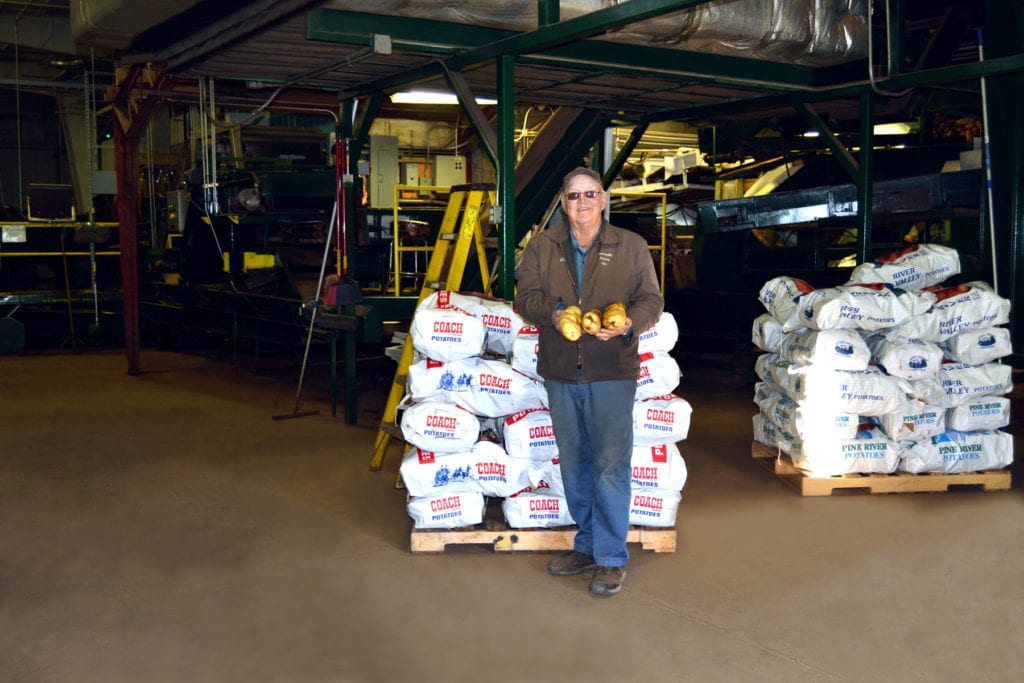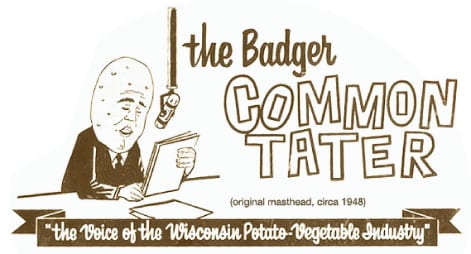
Farming in Wisconsin was a harsh environment in 1939, when Don Hamerski was born. Most family farms were self-supportive with goods produced on the farm to provide some cash income and buy supplies for crops and services
Daily tasks were labor intensive and physically exhausting: feeding livestock, milking cows by hand twice a day and cleaning up manure. Water was collected from the well or stream and there was constant log hewing, particularly in winter months, to provide wood for heat, timber for building and income from cash sales of the wood.

Some of the timber came from clearing land to produce more usable farm ground but this was also an extremely arduous task.
Farmers labored from sunup to sundown and hours mounted during planting and harvest seasons since everything was done by hand or powered by nature or horses.
In 1941, the U.S. was just emerging from the Great Depression. Many were looking forward to better times after a decade of hard times.
Then, on December 7, 1941, Pearl Harbor was attacked and the ensuing World War II meant that Americans would endure more hardships.
It even affected clothing and apparel because raw materials usually used for these items, were diverted to things like parachutes and military attire. Like many other items, shoes and boots were rationed so they became a prized possession and people took special care of them.
For farmers, the burden grew heavier since they now had to produce crops not just for local use but to help feed eight million U.S. soldiers on a daily basis, despite a shortage of farm workers, gas and new farm equipment and parts.
A lot of the regular farm help found new jobs off the farm as they were hired to make bombs, tanks or other materials which were built in new plants in rural areas across the nation. These plants and military training bases were built far from the coasts where they might be less vulnerable to attack, sabotage or spying.

Don Hamerski, Hamerski Farms, Inc. spent his early formative years in this environment. Don’s father, Joe, had just assumed the reins of the farming operation in 1940 from Don’s grandfather, Paul, who started the farm, 127 years ago, in 1889.
Don, in turn, grew up working on the farm, and in 1961, formed a partnership with his father, eventually taking over in 1964. Don now farms with his son, Jon, and his nephew, Dale O’Brien. According to Don, “I used to be youngest and now I am the oldest farmer.”
PROGRESSION
Constantly evolving, Hamerski Farms, Inc. headquartered in Plover, WI, now has 2300 acres of farmland extending into the Bancroft area.
The farm employs 22 employees between mid-July through the end of February and has moved beyond just the cows, potatoes and corn of Don’s grandfather’s day to a variety of potatoes including Norkodah, Gold Rush, Silverton, Superior, Red Norland and others along with sweet corn, snap beans, field corn, sweet peas and beans.

This interview focuses primarily on Don’s history in those early years, hoping to provide a glimpse into Don’s past and unlock the keys the led to such a successful future as well as provide a history of what it was like to farm in such severe circumstances.
What are your earliest remembrances of farming with your dad or grandpa and living on the farm?
I was the youngest but like my siblings (oldest sister was born in 1930 followed by another sister born in 1931), I started working on the farm 6-7 hours a day when I was only 4-5 years old, picking Colorado beetles off potatoes and dropping them into kerosene in a pail because that would kill them.

After the potatoes were debugged, I would go pick cucumbers and beans and helped tend to the cows as well as chickens, ducks and geese.
I hated the geese as well as the roosters because they were just plain mean. You never knew when or if, they would chase you or just ignore you.
This may seem strange to people today, working at such a young age, but back then, it was pretty much the norm.
Later, when I was 6-7 years old and World War II was in its heyday, there was a lot of stuff you could not buy and you made do with what you whatever you could get. Sugar was a luxury and clothes consisted of ‘hand me downs’ and for the girls, dresses made out of flour sacks.
We all washed up in a washtub. There was no running water, no electricity, no bathrooms or toilet, only the outhouse or the great outdoors.

Can you describe the equipment you used back then?
Farming was literally a ‘dirty business’ because all equipment was pull-type and hooked to horses rather than self-propelled. There was no cab or umbrella to shield you from the sun except when you were cultivating.
Later, when we did get tractors, there were no cabs and no umbrellas and when you combined, chaff was everywhere.
‘Dirty’ fell far short of describing how the dirt and chaff squeezed into every pore of your skin particularly because the wind never seemed to blow in the right direction.

It was still better than working with horses, because horses get spooked and take off. However, the horses were smart and could tell what was cultivated and what was not.
The first time I worked the cultivator with a horse, I was only 6-7 years old and the corn was a foot high. A rabbit spooked the horse and it drug me 200-300 feet, ruining everything in its path.
I thought I would get in big trouble but my Dad was more scared that I could have gotten hurt very badly because if a horse knows you are scared (which they always do and I was), they almost go crazy and get out of control.

Jon also readily embraces change and seeks to improve the farming operation with the latest, state-of-the-art technology and equipment.
When I was 7-8 years old, I learned to drive a jeep using blocks for the pedals so I could help bale hay for cows. I would take the empty feeder out to the field and Mom and Dad would unload hay into it.
Later, I used the hay chopper. No matter what part you played in the haying process, though, it was hot, awful, awful hot with no wind to cool you off.
What was the community like back then?
In those days, nobody locked their houses or if they did, they used a skeleton key and all the neighbors knew where the key was hidden.
Everyone worked together and trusted each other and if they needed something, they helped each other. We were always exchanging food with each other.
My dad had a threshing machine so he went from farm to farm to help the neighbors thresh and only charged for the belts and other things that broke down with continuous use or needed servicing.

We also built things together as a group and had a barn raising, ourselves, when I was 10 years old.
Later, we all helped tear down the neighbor’s old house and then built a new one. Together, we also all pooled lumber and supplies and built build a small store.
Please share with us what it was like during the World War II years.
During World War II, we had a Model C Allis Chalmers tractor and a two-bottom plow to farm our own land. We then bought a John Deere A, which meant we had to sell the Allis Chalmers because you could only have one tractor per farm during the war years.
The number of tractors you were allowed to have was based on the number of acres you had and we did not have enough to get or keep more tractors.
Therefore, it did not matter what brand you had, International, Allis Chalmers, John Deere, Oliver or whatever, you were just glad to have one.

Being self-sustainable during these years, we all had livestock, but if you wanted to buy a baler, you had to apply to the government for permission to get one.
We raised potatoes and you had to sell a certain percentage to the government, which left you with just about enough money to raise the next crop.
Since labor was short on the farms during these years, farmers were given the opportunity to let Prisoners of War work on their land.
My Dad arranged for four German Prisoners of War work on our farm. I was only about four years old at the time but did not know what to think.

Luckily, the first time I met them in the fields, one of them spoke excellent English and told me that I did not have to be scared of them. He claimed they were forced to serve with the Nazis and did not agree with Hitler at all.
I spent quite a bit of time around all four and they were nice as could be and very hard workers.
Everyone supported the war effort and we were so proud we had an opportunity to help the troops. Families would even open their home to troops in the area, so they had a place to stay or eat dinner.
Close to the end of the war, Dad grew hemp, which was sold to the government to be used for parachute ropes.

School kids were also encouraged to bring milkweed pods to school and the government would bring truck to the schools and pick them up because these, too, were used to make parachute ropes.
Hemp was quite profitable for our farm and others like us, particularly since it was used in thousands more items other than parachute ropes like food, paint, fuel, clothing, construction materials and even cars.
When the war ended, the government outlawed the growing of hemp nationwide, presumably due to its drug connotations.
Gasoline and oil was limited and a number on your windshield designated what day on which you could buy gas.

Tires were rationed, too because rubber was needed form military equipment and tires. At an early age, kids like me learned how to take tires apart, fix and patch tubes.
The government rationed supplies of staples such as flour, sugar, spices, coffee, meat, fish, butter, eggs and cheese.
The Defense Department provided ration cards for all of those supplies and that was how you purchased these items from the stores.
If you had chickens and extra eggs, you could also bring the eggs to town and trade for groceries.
You had to grow your own wheat and barley and make your own bread because bread was not available at the stores.
The war ended in 1945 but the country remained under the same conditions pretty much until the 50s and then the North Korean War started.
What were the 1950s like?
When I got into my teens, we had mechanized a couple of tractors and were using them with a milking machine. Until then, our 20 cows were milked by hand and it took 5 minutes or more to milk each cow, consuming over an hour and a half each day.
A milk hauler would come pick up the milk and haul it to Nelsonville and Arnott. If you placed your order ahead of time, he brought you butter the next day.
The cans of milk had cold water in the bottoms to keep the milk cold. That water was then given to the cows to drink so nothing was wasted.
By this time, we had a pump for ground water but it took quite a long time to pump enough water for chickens and other livestock as well as the apple and plum trees if it got dry because everyone had an orchard.
I legally drove at 14 years old because back then, there was a special exemption for farm kids. Of course, I passed my driving test since I had been driving since I was six. However, you still did not waste precious and expensive gas and only drove to town when you could combine several needs into one trip.
The very first car I owned was a 1949 Pontiac and I was 20 years old when I bought it.
What are the biggest differences you see in farming today versus when you started farming with your father?
The only technology we had in my early years in farming was that we tested pH levels for our soils and that was about it.
Farmers moved from simply spreading manure for nutrients to fertilizers with different nitrogen, phosphorous and potassium blends.
Macronutrients and micronutrients had not entered the picture yet.
Nowadays, farming is a science and you really need to use a soil agronomist to determine your soil needs or you will not produce the yields you need to keep your farm prosperous. Today, you need to produce 400-500 cwt/acre versus the 50 bushel/acre of yesteryear.
Additionally, there are so many more types of potatoes that are planted unlike the mainstays of Chippewa for potato Chips Burbank and Russet White/Russet Sebago from the old days.
How has your operation kept up with the latest equipment along with new technologies?
We always strive to incorporate the newest technologies. All of our irrigation systems are computerized and operated remotely with control panels at the farm’s headquarters.
We now have self-propelled sprayers, Lenco harvesters and a 4-row Double L and several self-unloading bulk boxes. When we transport our 12-bottom John Deere plow, people often take photos of it because they have never seen a plow that big. Many of our 13 tractors are equipped with Auto-Farm automatic steering.
Our packing shed utilizes a Hagen automatic sizer and X-ray machine for hollow heart detection and Hagen X-ray heads on all four lanes. Our packaging software, allows us to pack just about any size potatoes for specialty packs, for exact size need when going through processing lines.
Our state of the art Fuji Ace EC-201 Robotic Palletizer is used in conjunction with a Volmpack Auto-Baler in the farm’s packing shed. This high-speed, technologically advanced robot can handle as much as 20 bags per minute and lift up to 400 pounds. We also have an Oldenberg automatic grader.
What was it like working on the WPVGA Legislative Committee in the 60s?
In 1960, water first began to be legislated. I was on the WPVGA legislative and water resource committee and went back and forth to Madison, burning the midnight oil, five days straight one week and four days straight the next week, working hard to get an appropriate water bill passed. Luckily, our hard work and efforts to explain how important our issues were to our region as well as the rest of the state, paid off and we succeeded in our efforts
My work with legislative bodies did not end there however, since I also served as Portage County Drainage commissioner for 27 years. As such, I worked closely with the DNR and other governmental agencies and we were the only district in Wisconsin to institute a 10-year maintenance agreement.
My theory is that it works best when all parties work together to achieve common goals rather than fighting each other.
Sure, there may be compromises but the result will usually be much more closely matched to a win-win solution for everyone.
Are there any new directions you will be pursuing in terms of farming or the procedures associated with it such as grading, processing or storage?
At the moment, I cannot think of any but we try to stay on top of anything new, particularly technology, review it carefully and see if it will make sense and fit into our operation with an appropriate return on investment.
If you could do anything different over the years, please describe what that would be.
I cannot really think of anything I would necessarily change. If I did something a certain way, I did it for a reason and not until I carefully considered it and reviewed negative and positive implications.
Most probably, if I could do anything over again, it would still be close to how I did it in the first place.
What advice would you give young farmers starting out today?
If you want a steady income, you might want to consider a career other than farming. You never know in farming is you will be up or down because there are so many variables, most of which, like weather, you cannot control.


